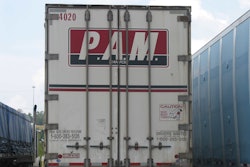The U.S. Environmental Protection Agency (EPA) and the California Air Resources Board (CARB) have presented preliminary proposals aimed at the alleged compliance loopholes found in current 2010 liquid-based selective catalytic reduction (SCR) systems on diesel engines. SCR technology doses engine exhaust with a urea-based diesel exhaust fluid (DEF). The resulting chemical reaction reduces emissions of oxides of nitrogen (NOx) pollutants to levels mandated by the EPA’s 2010 diesel emissions regulations.
Concerns about SCR’s environmental compliance were brought to CARB and EPA’s attention by truck and engine manufacturer Navistar International, which uses a competitive technology, exhaust gas recirculation (EGR) to meet EPA 2010 regulations. Navistar had sued both agencies over their acceptance of SCR technology without stronger measures to prevent engine operation without DEF or an operational SCR system. The truck maker settled both lawsuits by garnering a commitment for further review.
At an air resources workshop in, El Monte, CA, Navistar representatives contended that independent test findings show new commercial vehicles that must contain liquid urea to meet federal NOx emissions standards continue to operate effectively when urea is not present. At such times, Navistar said, the vehicles throw off levels of NOx as much as 10 times higher or more than when urea is present.
The research cited by Navistar was conducted by EnSIGHT, an independent environmental consulting firm, using two long-haul vehicles and one heavy-duty pickup, all of which use Selective Catalytic Reduction (SCR) technology that relies on liquid urea to clean up NOx emissions after they leave the engine.
According to Navistar, EnSIGHT’s research showed that when liquid urea was not present, there was little or no effect on the vehicles’ operations. This included long periods of time when the vehicles’ urea tanks were empty or were refilled with water instead of urea. One truck tested appears to operate indefinitely with water and as a result without any functioning SCR NOx control. That truck has accumulated more than 13,000 miles with its SCR NOx emission control turned off.
“Navistar first identified these loopholes to the agencies and also presented our concerns at today’s workshop,” said Jack Allen, president of Navistar’s North American truck group. “We will be working with the EPA and CARB to ensure full environmental compliance.”
“While others are saying there are ‘loopholes’ in the current 2010 regulations, we don’t agree with that terminology at all,” said Annette Hebert, Chief of Mobile Source Operations Division for CARB. “What we are doing is looking at tightening up SCR certification requirements and clarifying the guidelines so that manufacturers know exactly how to meet them.”
Hebert says CARB’s initial focus is on the time, speeds and mileage SCR trucks can operate once the DEF tank is empty. “We also want to make certain the trucks cannot operate when they are out of spec: If water has been placed in the DEF tank or the SCR system has been tampered with in any way,” she added. “Our goal is to minimize the time and speed a truck can operate and create driver inducements that are stringent enough to encourage them to keep DEF in the system and avoid any performance penalties.
“We’re looking at the information they (Navistar) have given us. And we need to add to that information: There are details missing and CARB will certainly have to look into those issues for ourselves. For example, are drivers or fleets tampering with SCR systems? And if they are, at what level is this alleged tampering taking place? We simply don’t know the answer to those questions right now.”
John Mies, vice president, corporate communications, Mack Trucks, and Volvo Trucks North America responded strongly to Navistar’s claims. “Thanks to billions of dollars in investment, and millions of engineering hours around the world, SCR manufacturers have successfully introduced into the North American market the cleanest diesel engines in the world,” Mies said. “Despite all the technical challenges, the introduction is probably the smoothest the industry has ever seen. And every single thing we’ve done – including the DEF inducement strategy – was done with the full cooperation, knowledge, and approval of both the EPA and the California ARB.
“In the midst of all this good news for our industry and the environment, we learned a few weeks ago – not even six months after the implementation date for the new technology – that the regulations we followed in good faith were to be reconsidered. And why? In large part because of concerns being raised by a single competitor. A competitor that says it is concerned about the environment, but whose US10 engines will emit two and a half times the 2010 NOx standard, and are only certifiable with emissions credits.”
Mies openly questioned Navistar’s motivation in raising SCR compliance issues with EPA and CARB, noting that “the competitor” challenging current SCR standards:
• “Said it was ready for the new standards, yet lobbied for a delay in implementation, and when that failed, resorted to lawsuits against the regulators.
• Apparently believes that most of its customers, and the trucking industry as a whole, are hell-bent on illegal circumvention of emissions controls.
• Has only been able to compete in the market this year by selling thousands and thousands of pre-2010 engines.
“The fact is that a Mack or Volvo truck running at 0.2 grams is and will continue to be much better for the environment than a Navistar truck running at 0.5 grams – and no amount of changes to the inducement strategies will change that,” Mies added. “As we have always done, Volvo will cooperate fully with the EPA and CARB as you consider this issue. But let’s make sure that what we do is truly in the interest of the environment and the public. And let’s not penalize those who have worked with you in good faith, and reward those who are trying to manipulate the system for their own competitive advantage.”
“Truck owners are paying a substantial price to comply with 2010 NOx requirements,” countered Allen. “They, and the public, deserve to know that the new equipment they are purchasing actually works as promised to curb pollution. It’s obvious, however, that these trucks can operate effectively without liquid urea, and that under these and other conditions, SCR NOx emission control is turned off. We’re calling on the EPA and CARB to assure that all vehicles, not just ours, work when they are supposed to be working.”
Hebert stresses that CARB does not support one technology over another. “We are neutral in that area,” she said. “In the eyes of the law, both Navistar and the SCR manufacturers are compliant right now. It’s true that Navistar is certified at a higher NOx gram output currently. But that doesn’t matter to CARB, because — again — they are compliant under current law.”
Hebert says there will be no rush to judgment on CARB’s part: “We’re going to take our time with this and gather a lot of information,” she said. “Our intention, from the very beginning, has been to start SCR off with relatively lenient compliance certifications. Because initially, we didn’t know if DEF would be readily available and we didn’t want drivers unduly penalized if they simply could not find DEF. But, as time went on, and the technology matured and DEF became more available nationally, it was always our intention to begin tightening SCR compliance regulations to reflect that situation.”












